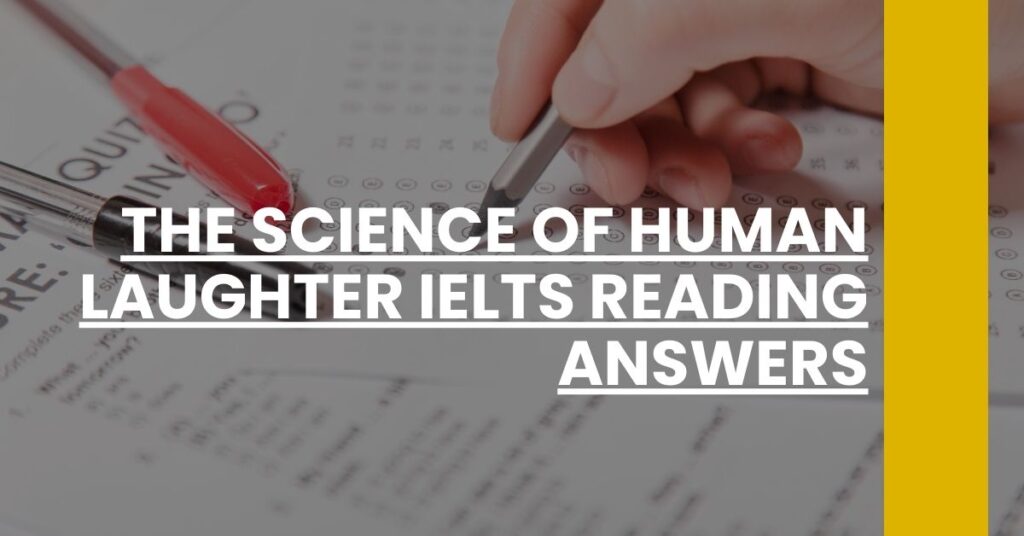Master the science of human laughter IELTS reading answers with our insightful guide.
- Biological Mechanisms: Understand how laughter’s physiological underpinnings appear in IELTS passages.
- Psychological Triggers: Identify laughter’s cues in test contexts for better comprehension.
- Cultural Nuances: Grasp the global scope of humor as it pertains to IELTS questions.
Ace your IELTS with our focused science of human laughter insights.
- Understanding the Physiology of Laughter
- The Psychology Behind Laughter
- Evolutionary Perspectives on Laughter
- Types of Laughter and Their Meanings
- The Benefits of Laughter
- Laughter in Language and Culture
- Deciphering Laughter for IELTS Reading Answers
- Common IELTS Reading Themes on Laughter
- Conclusion: The Intersection of Laughter Science and Language Testing
Understanding the Physiology of Laughter
Unraveling the science of human laughter requires a deep dive into the intricate biological orchestra that ignites this universally recognized expression of joy, surprise, or nervousness. But why do we laugh, and what happens in our bodies when we do? Let’s explore.
The Brain’s Role in Producing Laughter
Brain regions: When you experience something funny, various brain regions light up. The prefrontal cortex works on the language processing and appreciation of the humor, while deeper areas like the amygdala and hippocampus process the emotional response. Deeper brain areas trigger the physical act of laughing.
The Laughter Cascade
Respiratory system and muscles: From the first chuckle, a cascade effect occurs. Your respiratory system kicks into gear, your diaphragm spasms, and your vocal cords shut with each breath you draw. The result is a distinctive series of vocal outbursts—what we recognize as laughter.
The Feel-Good Chemicals
Endorphins: Laughter triggers your brain to release a cocktail of happiness-inducing chemicals. Among these, endorphins are paramount. Acting as natural painkillers, they foster a sense of well-being and can temporarily relieve pain.
The Psychology Behind Laughter
Delving into the psychology of laughter exposes the complexities behind this seemingly straightforward behavior. Laughter isn’t merely a response to a funny joke; it intertwines deeply with our social fabric and mental health.
Humor Appreciation and Emotional Triggers
Cognitive appraisals: Your perceptions, beliefs, and expectations shape your sense of humor, indicating the subjectivity of what we find humorous.
The Social Glue
Laughter as a social tool: It’s a building block of human connection, forging bonds by fostering a shared experience in group settings.
Laughter’s Healing Power
Therapeutic effects: The adage “laughter is the best medicine” isn’t far off. Laughter therapy has shown promising results in improving psychological functions among various groups, hinting at its potential use in mental health management.
Evolutionary Perspectives on Laughter
The evolutionary roots of laughter offer a window into the primal functions of laughter that extend beyond today’s jovial chortles.
Laughter for Social Bonding
A tool for connection: Laughter might have evolved to foster group cohesion, essential for survival in early human societies. This evolutionary mechanism underscores laughter’s role as a social lubricant even today.
Communicating without Words
Non-verbal messaging: Before the complexity of language, laughter served as a pre-linguistic form of communication. It conveyed safety, playfulness, and acceptance without the need for words.
Types of Laughter and Their Meanings
Laughing isn’t a one-size-fits-all response. Instead, it’s a nuanced behavior that varies in authenticity, intent, and social function.
Genuine Versus Social Laughter
- Duchenne laughter: This spontaneous and uncontrollable laughter, involving both the eyes and mouth, signals genuine joy or amusement.
- Social laughter: More controlled and less about hilarity, social laughter serves diplomatic purposes—it’s about being polite or fitting into a social context.
The Language of Laughter
Emotional expression: Laughter can convey a range of feelings from joy to discomfort. It might be a heartfelt guffaw in response to delight, a nervous giggle during awkward moments, or a burst of shared laughter creating an instant bond.
Mirroring Connections
Empathetic reactions: The sound of laughter triggers mirrored responses in listeners, facilitated by the brain’s mirror neuron system. These reactions enhance our ability to empathize and connect with others, proving laughter’s indispensable role in human interaction.
As you delve into the IELTS reading passages on the science of human laughter, the understanding of these physiological and psychological facets will arm you with the answers you seek, enriching your test preparation journey.
The Benefits of Laughter
Laughter isn’t just a spontaneous and often enjoyable part of human interaction; it offers a variety of benefits that span both mental and physical health. Understanding these advantages can not only help inform your own health choices but can also enhance your comprehension of related topics within IELTS reading assessments such as “the science of human laughter IELTS reading answers.”
Enhancing Mental Health with Laughter
- Elevates Mood: When you laugh, your body releases a slew of neurotransmitters and hormones that elevate your mood. This natural mood booster can be a key factor in maintaining emotional balance.
- Reduces Stress: Laughter has the power to reduce the level of stress hormones like cortisol, which in turn can help alleviate stress-related ailments.
- Increases Resilience: Learning to laugh at challenges and view life with a sense of humor can increase your psychological resilience, a trait that IELTS reading passages often reference when discussing personal development.
Physical Health Perks
- Boosts Immunity: Regular laughter can enhance your immune system by increasing the production of antibodies and activating protective cells.
- Pain Relief: The endorphins released during laughter act as the body’s natural painkillers and can help lessen chronic pain.
- Improves Cardiac Health: Laughter increases blood flow and improves the function of blood vessels, which can help protect you against cardiovascular problems.
Laughter in Language and Culture
Laughter transcends cultural barriers, yet every culture has its own unique triggers and interpretations of laughter. When preparing for IELTS, understanding these cultural nuances could help you decode complex reading passages more efficiently.
Laughter as a Universal Language
Even though the triggers for laughter might differ across cultures, the physiological response is universally recognized. Grasping this could enable you to better navigate questions about social interactions in various cultural contexts.
Laughter in Cultural Narratives
- Cultural Variability: Different societies place varying degrees of significance on laughter and humor, an aspect often discussed in IELTS passages.
- Language Learning: Humor can also play an intriguing role in language proficiency tests; recognizing the subtleties of humor in a second language may indicate a high level of linguistic and cultural understanding.
Deciphering Laughter for IELTS Reading Answers
When tackling the topic of laughter in IELTS reading passages, your approach shouldn’t be much different from analyzing any other subject matter. Once you’ve combed through the text, apply the following key strategies:
Identifying Context and Nuance
- Main Ideas versus Details: Distinguish between the primary themes and the supporting information – a fundamental strategy for grasping the context of laughter-related content.
- Analytical Reading: Go beyond a superficial reading to decode subtle messages relating to the science of human laughter that can often be hidden within texts.
Interpreting Question Styles
- True/False/Not Given Questions: Assess statements about laughter based on facts from the passage, applying critical analysis to ensure accurate responses.
- Multiple-Choice Questions: Draw on your understanding of the content and context to eliminate incorrect answer options and zero in on the correct choice.
Common IELTS Reading Themes on Laughter
When you embark on your IELTS reading practice, you might come across recurrent laughter-themed topics. Familiarize yourself with these motives to enhance your test-taking prowess:
Recurrent Themes
- Physiological Grounds of Laughter: Understanding the biomechanics of laughter can help you answer questions about general science or health.
- Laughter in Social Dynamics: You should be equipped to discuss how laughter facilitates social bonding, a frequent discussion point in IELTS texts.
Conclusion: The Intersection of Laughter Science and Language Testing
The study of laughter is extensive, spanning disciplines such as psychology, sociology, physiology, and even linguistics. As an IELTS candidate, you must appreciate the multifaceted nature of laughter. While diving into passages about the science of human laughter, remember that each line could yield clues not just to questions about laughter itself, but also about human behavior, health, and cultural dynamics. Your acumen in deciphering the cues embedded in passages can significantly influence your IELTS reading score. Therefore, cultivate an in-depth understanding of laughter, and you’ll be equipped to tackle related reading answers with confidence and finesse.
Discover key IELTS reading answers through the science of human laughter: explore biology, psychology, and cultural implications in laughter research.

